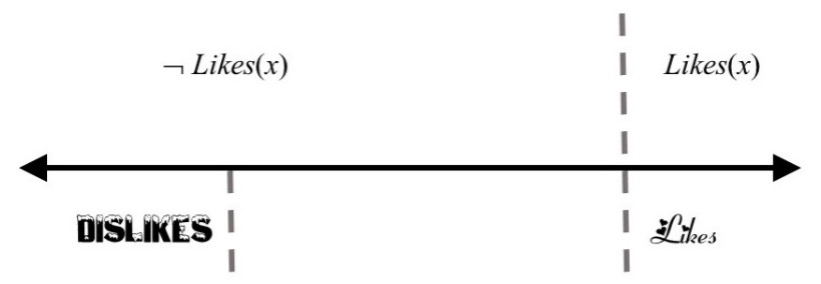Subsection 7.2.9 Ambiguity of Some Logical Operators – NEGATION
In logic, for any predicate P, we can write both:
[1] P(x)
[2] ¬P(x)
Given some appropriate definition of P, The Law of the Excluded Middle tells us that, for any x in P’s domain, one of these claims must be true. And, if we write many simple claims in English, it will also be the case that either the claim or its apparent negation must be true.
So, for example, we could write:
[1] French(Jean) Jean is French. [2] French(Jean) Jean isn’t French.(with respect to whatever definition of the predicate French we have provided).
But this doesn’t always happen, particularly when we allow for the variety of ways of expressing negation in English.
Consider:
[1] Travis likes Jody.
[2] Travis doesn’t like Jody. (an apparently simple negation of [1])
Must one of those sentences be true? It depends on what [2] means. It could mean either:
[3] It is not the case that Travis likes Jody.
[4] Travis dislikes Jody.
If it means [3], then yes, one of [1] and [3] must be true. We can express this as a logical claim:
Likes(Travis, Jody) Likes(Travis, Jody)
But if it means [4], no, it is not necessarily the case that one of [1] and [4] must be true. It is possible that Travis knows nothing about Jody. Or perhaps Travis is neutral about Jody. Then both [1] and [4] are false. Travis neither likes nor dislikes Jody.
Have we violated the Law of the Excluded Middle in a case like this? No. “Dislikes” is not equivalent to “not likes”.
The problem is that many of the more natural tools that English gives us for expressing negations (including “doesn’t”, and prefixes such as “dis-”, “un-”, “il”-, and so forth) are almost like logical negation, but not quite. Often this happens because the property that is being described can best be thought of as describing, not a dichotomy, but rather points on some spectrum. In this case, we often define a logical predicate that corresponds to some part (typically one end) of that spectrum. Then its negation must cover all of the rest. Yet related negative words in English often apply only at the other end.
Some adjectives correspond to dichotomies, but many don’t.
“Legal” does correspond to a dichotomy:
Illegal is equivalent to LegalAnything in the domain of Legal must either be legal or not legal (illegal).
“Likely” doesn’t correspond to a dichotomy:
Unlikely is not equivalent to LikelySomething with probability close to 50/50 is neither likely nor unlikely.
Later, we’ll have more to say about the difficulty of dichotomizing our analog world and the vague words we tend to use when we attempt to do that.
Big Idea
The Law of the Excluded Middle says that, for any statement P, P or P is true. It doesn’t say that P or some Q that may seem like not P must be true. If Q is not exactly P, then it’s possible that there are more than two alternatives. Failure to recognize that can lead to the logical error called a False Dichotomy.
A classic example of this is the expression, “If you’re not with us, you’re against us.” The phrase “against us” is not exactly equivalent to “not with us”. It’s possible to be neutral. Unfortunately, people who are trying to make a point may say things like this and hope that their listeners will be fooled into believing their argument.
Exercises Exercises
Exercise Group.
Let’s say that a pair of claims C1 and C2 sets up a “true dichotomy” if, for any x in the domain of C1 and C2, C2(x) is equivalent to ¬C1(x). In this case, the Law of the Excluded Middle says that C1(x) or C2(x) must be true. For example, Legal(x) and Illegal(x) set up a true dichotomy. Likely(x) and Unlikely(x) don’t.
In each of the following examples, the second of the two claims is an English negation of the first. Indicate whether or not the two claims set up a true dichotomy. In other words, is the second claim the logical negation of the first?
1.
Let the domain be the set of tasks to be accomplished.
C1 : x is complete.
C2 : x is incomplete.
True dichotomy
False dichotomy
2.
Let the domain be the set of people. Assume that we’re using “sensitive” in the sense of a personality trait.
C1 : x is sensitive.
C2 : x is insensitive.
True dichotomy
False dichotomy
Correct answer is B.
Explanation: When we say that someone is “sensitive”, we are saying that he is at the high sensitivity end of the sensitivity spectrum. When we say that someone is “insensitive”, we are saying that he’s at the low sensitivity end. There’s still the possibility of being in the middle.
3.
Let the domain be the set of people.
C1 : x is smart.
C2 : x isn’t smart.
True dichotomy
False dichotomy
Correct answer is B.
Explanation: When we say that someone is smart, we are saying that she’s at the high intelligence end of the IQ spectrum. When we say that someone isn’t smart, we almost always mean that she’s at the low intelligence end. There’s still the possibility of being in the middle.
4.
Let the domain be the set of decisions.
C1 : x is fair.
C2 : x isn’t fair.
True dichotomy
False dichotomy

